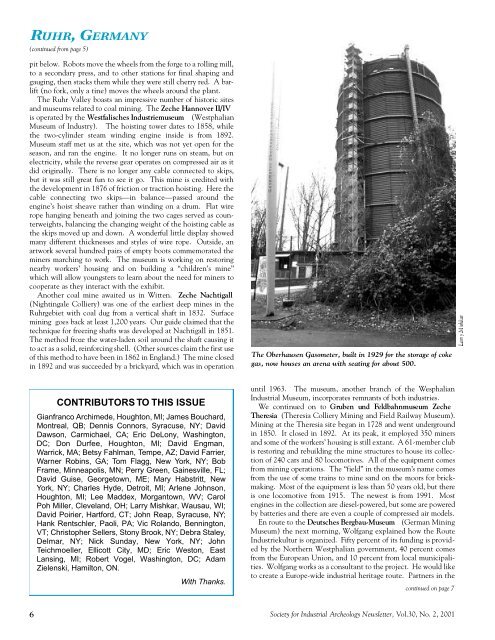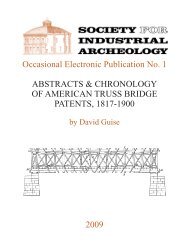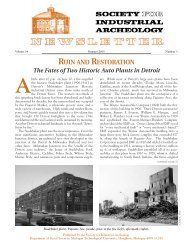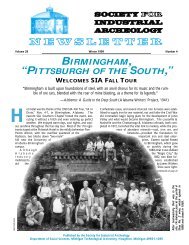RUHR, GERMANY - Society for Industrial Archeology
RUHR, GERMANY - Society for Industrial Archeology
RUHR, GERMANY - Society for Industrial Archeology
Create successful ePaper yourself
Turn your PDF publications into a flip-book with our unique Google optimized e-Paper software.
<strong>RUHR</strong>, <strong>GERMANY</strong><br />
(continued from page 5)<br />
pit below. Robots move the wheels from the <strong>for</strong>ge to a rolling mill,<br />
to a secondary press, and to other stations <strong>for</strong> final shaping and<br />
gauging, then stacks them while they were still cherry red. A barlift<br />
(no <strong>for</strong>k, only a tine) moves the wheels around the plant.<br />
The Ruhr Valley boasts an impressive number of historic sites<br />
and museums related to coal mining. The Zeche Hannover II/IV<br />
is operated by the Westfalisches Industriemuseum (Westphalian<br />
Museum of Industry). The hoisting tower dates to 1858, while<br />
the two-cylinder steam winding engine inside is from 1892.<br />
Museum staff met us at the site, which was not yet open <strong>for</strong> the<br />
season, and ran the engine. It no longer runs on steam, but on<br />
electricity, while the reverse gear operates on compressed air as it<br />
did originally. There is no longer any cable connected to skips,<br />
but it was still great fun to see it go. This mine is credited with<br />
the development in 1876 of friction or traction hoisting. Here the<br />
cable connecting two skips—in balance—passed around the<br />
engine’s hoist sheave rather than winding on a drum. Flat wire<br />
rope hanging beneath and joining the two cages served as counterweights,<br />
balancing the changing weight of the hoisting cable as<br />
the skips moved up and down. A wonderful little display showed<br />
many different thicknesses and styles of wire rope. Outside, an<br />
artwork several hundred pairs of empty boots commemorated the<br />
miners marching to work. The museum is working on restoring<br />
nearby workers’ housing and on building a “children’s mine”<br />
which will allow youngsters to learn about the need <strong>for</strong> miners to<br />
cooperate as they interact with the exhibit.<br />
Another coal mine awaited us in Witten. Zeche Nachtigall<br />
(Nightingale Colliery) was one of the earliest deep mines in the<br />
Ruhrgebiet with coal dug from a vertical shaft in 1832. Surface<br />
mining goes back at least 1,200 years. Our guide claimed that the<br />
technique <strong>for</strong> freezing shafts was developed at Nachtigall in 1851.<br />
The method froze the water-laden soil around the shaft causing it<br />
to act as a solid, rein<strong>for</strong>cing shell. (Other sources claim the first use<br />
of this method to have been in 1862 in England.) The mine closed<br />
in 1892 and was succeeded by a brickyard, which was in operation<br />
CONTRIBUTORS TO THIS ISSUE<br />
Gianfranco Archimede, Houghton, MI; James Bouchard,<br />
Montreal, QB; Dennis Connors, Syracuse, NY; David<br />
Dawson, Carmichael, CA; Eric DeLony, Washington,<br />
DC; Don Durfee, Houghton, MI; David Engman,<br />
Warrick, MA; Betsy Fahlman, Tempe, AZ; David Farrier,<br />
Warner Robins, GA; Tom Flagg, New York, NY; Bob<br />
Frame, Minneapolis, MN; Perry Green, Gainesville, FL;<br />
David Guise, Georgetown, ME; Mary Habstritt, New<br />
York, NY; Charles Hyde, Detroit, MI; Arlene Johnson,<br />
Houghton, MI; Lee Maddex, Morgantown, WV; Carol<br />
Poh Miller, Cleveland, OH; Larry Mishkar, Wausau, WI;<br />
David Poirier, Hart<strong>for</strong>d, CT; John Reap, Syracuse, NY;<br />
Hank Rentschler, Paoli, PA; Vic Rolando, Bennington,<br />
VT; Christopher Sellers, Stony Brook, NY; Debra Staley,<br />
D e l m a r, NY; Nick Sunday, New York, NY; John<br />
Te i c h m o e l l e r, Ellicott City, MD; Eric Weston, East<br />
Lansing, MI; Robert Vogel, Washington, DC; Adam<br />
Zielenski, Hamilton, ON.<br />
With Thanks.<br />
The Oberhausen Gasometer, built in 1929 <strong>for</strong> the storage of coke<br />
gas, now houses an arena with seating <strong>for</strong> about 500.<br />
until 1963. The museum, another branch of the We s p h a l i a n<br />
<strong>Industrial</strong> Museum, incorporates remnants of both industries.<br />
We continued on to Gruben und Feldbahnmuseum Zeche<br />
Theresia (Theresia Colliery Mining and Field Railway Museum).<br />
Mining at the Theresia site began in 1728 and went underground<br />
in 1850. It closed in 1892. At its peak, it employed 350 miners<br />
and some of the workers’ housing is still extant. A 61-member club<br />
is restoring and rebuilding the mine structures to house its collection<br />
of 240 cars and 80 locomotives. All of the equipment comes<br />
from mining operations. The “field” in the museum’s name comes<br />
from the use of some trains to mine sand on the moors <strong>for</strong> brickmaking.<br />
Most of the equipment is less than 50 years old, but there<br />
is one locomotive from 1915. The newest is from 1991. Most<br />
engines in the collection are diesel-powered, but some are powered<br />
by batteries and there are even a couple of compressed air mod e l s .<br />
En route to the Deutsches Bergbau-Museum (German Mining<br />
Museum) the next morning, Wolfgang explained how the Route<br />
Industriekultur is organized. Fifty percent of its funding is provided<br />
by the Northern Westphalian government, 40 percent comes<br />
from the European Union, and 10 percent from local municipalities.<br />
Wolfgang works as a consultant to the project. He would like<br />
to create a Europe-wide industrial heritage route. Partners in the<br />
continued on page 7<br />
6 <strong>Society</strong> <strong>for</strong> <strong>Industrial</strong> <strong>Archeology</strong> Newsletter, Vol.30, No. 2, 2001






